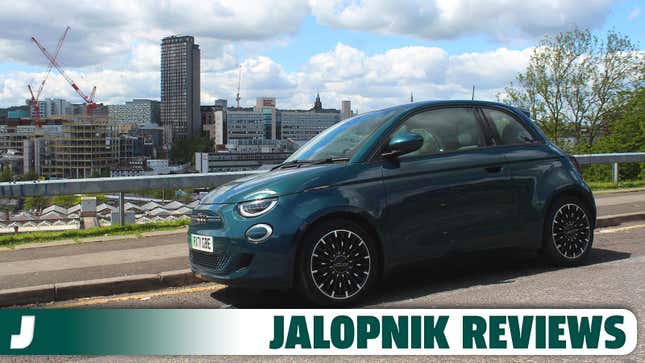
Like it or not, the all-electric Fiat 500 is coming to our shores next year in a last attempt from Fiat to break into the American market. On the surface, it’s a compelling little car with space for four, a claimed 199-mile range and cutesy styling that makes it stand out from the crowd. But is that enough to make it appeal to an American audience? I, Jalopnik’s resident Brit, flew home for a week to try and find out.
Full disclosure: Fiat lent me a fully-charged, fully-specced Fiat 500 Icon to drive around the UK’s city and country roads for a few days. They did not cover the flights home, don’t worry
What Is It?
Unveiled in 2020, the new Fiat 500 is an all-electring re-imagining of the Italian brand’s iconic city car. Currently available across Europe and select global markets, the electric 500 I’m driving is the top-of-the-line Icon model, which is packed with an 87 kw motor that produces 118 HP. It’s powered by a 42 kW battery, which Fiat claims is enough to give the car up to 199 miles of all-electric range.

My test car came finished in this gorgeous ocean green color, which is paired with light gray and blue fabric seats front and rear. There was also an optional panoramic sunroof, wireless phone charging and body-colored door mirrors to bring the on the road price to £32,265, which includes 20 percent tax. That’s equivalent to about $41,000 (at the time of writing), which is a lot for a car of this size – but UK and U.S. car prices are tricky to compare. So let me just say that on the road in Britain, this car will set you back about as much as an all-electric Mini, which starts at $30,900 stateside.
For that lofty price tag you get a pretty great looking car. The Fiat 500 has always been cute, but the updates Fiat made to this electric model really help the design pop. Those half-winking headlights are awesome, and the slight flattening where the grille would have been is a nice touch. Sure, we lose the cool body-colored panels in the tail lights that were present on 500s of old, but they were never going to make it to the States, so now we’re all equal.
The car I have is the hatch, but you can also get the all-electric 500 in a convertible, with a folding fabric roof. So far, Fiat hasn’t confirmed which models will make it Stateside.
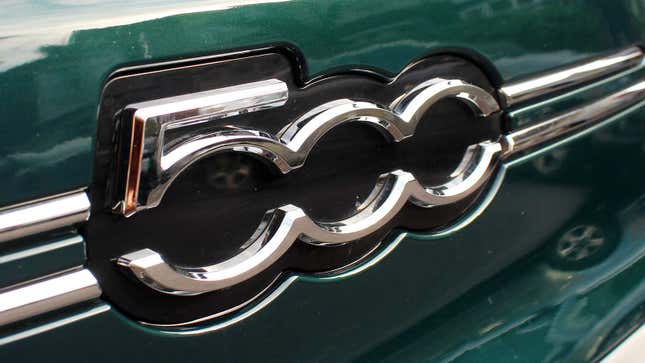
How Does The Fiat 500 Drive?
If you ask me, small electric cars like this just make sense. They’re great for covering short journeys like a trip to work or out for groceries and they help cut emissions in city centers, making the air safer and nicer to breathe for anything that lives there. And thankfully, despite a 660-pound weight gain over the gas-powered Fiat 500, the all-electric model still feels like a lovely little city car.
On London’s tightly-packed streets, the steering is super light and the driving position is good. You don’t feel too low to the ground even when surrounded by London’s iconic red buses, and you have solid visibility all around. This means there should be no worries about catching its gleaming paintwork on anything while squeezing around and this, coupled with the 500’s diminutive dimensions, makes it an easy car to park.
When you’re driving around town, you’ll want to keep the car in its Range or Sherpa modes. These two, along with the Normal setting, change the way this car drives in order to maximize range, or they can keep things feeling familiar.
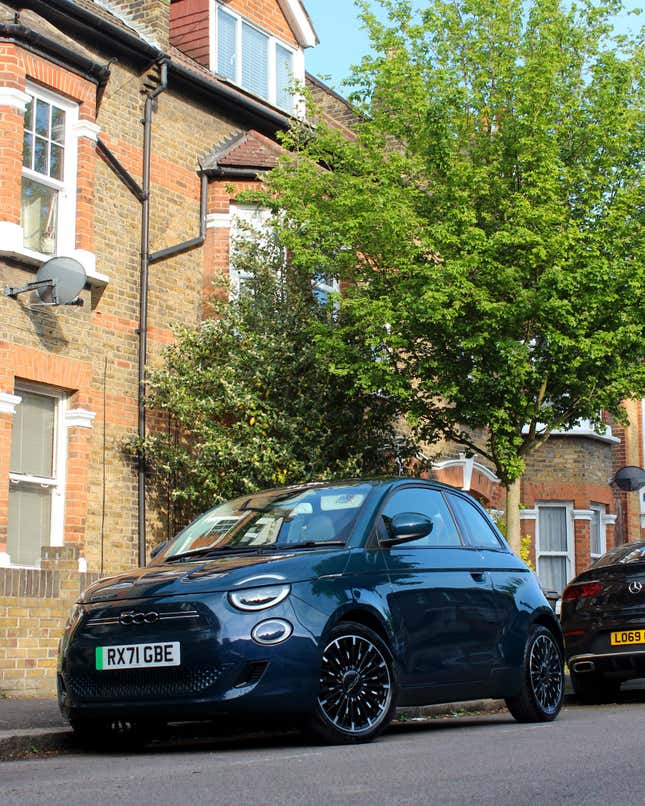
Range gives you the one-pedal driving experience you want in an EV, with regenerative braking kicking in whenever you take a foot off the accelerator. Sherpa does this too, but minimizes some features inside the cabin, like AC, to make your battery go even further. In Normal, it operates just like a regular automatic car.
Other than the ease of one-pedal driving, the only time I noticed a real difference between the eco-minded settings and the cars normal mode came when trying to park. In Range or Sherpa, reversing into a parking space or carrying out another such low speed maneuver can be awkward. I’m sure it’s something that you’d adapt to over time, but the power seems to snap on and off with either a hint of the accelerator or brake. You end up carrying out a process similar to that of finding the bite point in a manual car after each time you apply the brakes.
Parking drama aside, the Fiat is great fun to drive. Its power is up by 48 HP compared to the gas-powered model, and this means that despite the extra pounds on the electric model, it’s fast and fun.
An excursion through the country roads in the Peak District National Park in northern England put the handling to the test. In the corners, it doesn’t feel like it’s lumbering around, and instead stays nimble. What’s more, the instant power of an electric motor makes it rapid to get back up to speed on the exit. It’s fun, thankfully.
The same instant power is handy to have on highways as well. A lot of small cars can feel outpaced on the motorway, but in the Fiat it’s quick to reach cruising speeds and overtaking doesn’t feel like a gamble every time you swap lanes to pass someone. Instead, the car just keeps accelerating to ease ahead of traffic.
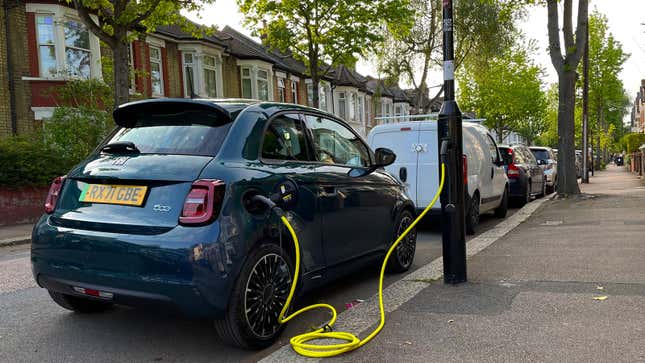
That’s Great, But What About When You Need To Charge?
Cruising up and down the UK’s motorway network was never going to be easy on the Fiat 500’s battery. Out of the box, Fiat says the 42 kW battery will give you 199 miles of range, but I didn’t find it to be quite that good in the real world.
On average, I’d say I could cover closer to 160 miles before I was looking for a charge point. This figure was replicated on the dash, which was pretty accurate at calculating the range I had remaining. On one trip, I left with 120 miles of range displayed on the dash, covered 80 miles and reached my destination with 40 remaining – so it’s good to have that confidence in the onboard calculator.
When you do have to plug in and top up, the UK faces most of the same charging issues we have here in America – not enough ports, gas-powered cars parking in charging spaces and out of order plugs.
But at least when you do find one that’s available, the Fiat is very quick to charge. The 500 can charge at a rate of up to 85 kW, and when you find a fast charger its top-up times are rapid. I stopped with 30 percent battery remaining, and after a 20 minute coffee break, the battery was back up to 80 percent and showing a further 125 miles of range. Obviously, charge times are much slower at chargers like the on-street lamp post plugs you find in London. There, an overnight charge from 20 percent up to 100 took just over ten hours.
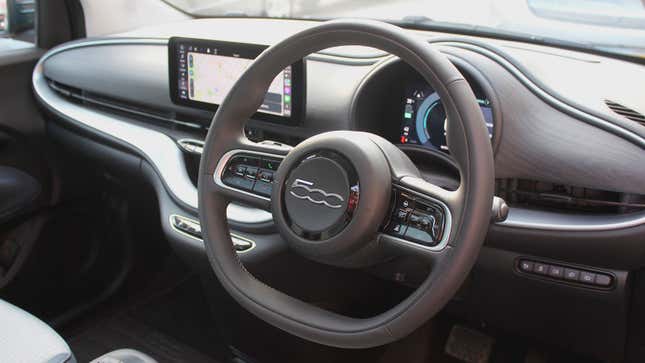
Is There Really Space For Four?
While waiting for the car’s batteries to top up, there’s time to explore the interior of the Fiat. And, I’m pleased to say, it’s a pretty nice space to pass the time.
My review unit was swathed in light gray and blue fabric, while the dash had a pale silver surround and gray finish. At the center is a 10.25-inch touch screen that operates the climate controls, media center and navigation. This worked well, and pairs easily with Apple Carplay or Android Auto for ultimate ease of use. If you rely on the car’s built-in navigation instead, it will recommend charging stops on any route that’s longer than your predicted range.
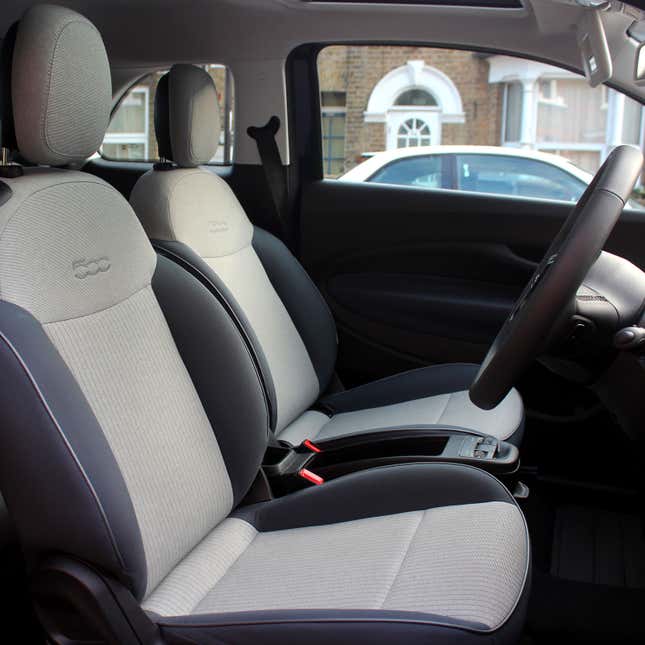
Beneath the screen is a row of tactile buttons for climate controls, and under that was a wireless charge pad inscribed with an image of the skyline in Torino, where Fiat is based. There are further nods to the car’s Italian origins in the door handles, which had inscriptions reading “made in Torino.”
The space itself is comfy. There’s a good amount of support in the driver’s seat, and both front seats are easily customizable to fit your body shape. With nobody in the rear, there’s also a good amount of legroom up front for taller riders. When you do put two passengers in the rear bench seat, there’s space to seat a couple of adults and the seating remains pretty padded and comfortable. But this is a small car, so legroom isn’t enormous and I probably would want to get out for a stretch every hundred miles or so. I guess that aligns with the moments you need to stop and recharge nicely.
There’s also a decent sized trunk despite the car’s diminutive dimensions. You get about nine cubic feet of space, which I found was plenty of room for a grocery run, or to carry the luggage for two travelers for a couple of weeks in the UK – but I’ll admit we pack quite light. There’s sadly no frunk space in the Fiat, so you have to make do with the room you have out back.

OK, But Did You Like The Electric Fiat 500?
All in all, the electric Fiat 500 is a neat proposition for anyone looking to dip a toe into the world of EVs. It’s familiar to many, thanks to its iconic looks and the way it handles in Normal mode, but will also introduce you to a new way of driving – think one-pedal operation and queues for charging ports.

I’m excited to see how it’s received when it does make it over to the U.S. in 2024. The model we’ll get is set to be unveiled at the LA Auto Show later this year, when we should hear more about its performance and pricing. But regardless of the specs Fiat rolls out at the show, it’ll be nice to see the Italian automaker take another real crack at the American market with a car that will stand out from the crowd.
And, with a range that should easily cover your commute and most journeys you’ll make around town, as well as space for four people and a good amount of luggage room in the rear, it could be enough EV for the average American motorist. Let’s hope it can be priced in a way that attracts first time EV buyers here, instead of into the driver’s seat of yet another oversized electric SUV.